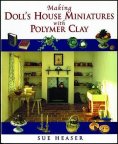

Reviewed

 "Making Doll's House Miniatures with Polymer Clay" by Sue Heaser
Reisl Lackinger
"Making Doll's House Miniatures with Polymer Clay" by Sue Heaser
Reisl Lackinger
Staff Writer
In the world of miniatures, one of the easiest materials to work with is polymer clay. Polymer clay is so versatile and can be fashioned into anything the hobbyist or miniaturist may need for the dollhouse. The possibilities are endless. Sue Heaser's how-to book, "Making Doll's House Miniatures with Polymer Clay" is a great learning tool for the beginner and a good reference for the more advanced artisan. First published in 1997, it can be found on Amazon for as low as US$13.50.
As with many hobbyist how-to books, Heaser starts off with an intro of the materials and tools needed to complete projects and brief descriptions of brands of clay along with pros and cons. While the intro is more than likely going to be skipped over by the advanced artisan, the next chapter on Techniques is an excellent resource to look back on for ideas. This chapter covers everything from instruction in creating your own stamps and molds from the clay itself to mixing colors along with very basic information for making clay shapes and finishing methods.
Her project techniques are also outstanding. Instructions for creating faux effects such as copper or silver, marble and china are included as are ways to make grooves for more realistic spindles found in wooden furniture. Now, for the meat of the book and the reason I would recommend it: The projects. Heaser's projects stand out. While many books focus on a particular area of using polymer clay, such as wholly devoted to creating food, jewelry, plants, etc, this book incorporates a little bit of everything that may be created using polymer clay in the dollhouse.
This approach is a great advantage. It gives the aspiring artisan the chance to try their hand at many different types of miniatures and lets them decide from experience whether they prefer creating food, kitchenware, or home accessories.
The chapters are divided into projects by room. I am a very big fan of this format. Projects ranging from foods for the kitchen, plants in the bedrooms, a sewing box in the sewing room to any-room accessories such as teapots, dishes, clocks, books, vases, jewelry, small scale furniture and even working lamps. Each project gives the standard materials list and clay color mixtures needed, step by step instructions and pictures showing the steps in action.
The pictures are one of the few negatives I have about the book. Most are not actual photos but black and white drawings. I have never been a fan of drawn steps to making my crafts and to do them in black and white just makes it worse. I much prefer actual photos and in color. While there are actual photos of the real projects and in color, there just aren't enough.
The standout projects in the book are the plants and instructions for making everyday dishes and fine china. The geraniums are particularly but time consuming - Heaser instructs you to cut each little petal. However, the steps are very basic and easy to follow. The technique to make the terra cotta pot for holding the geraniums is even included. The dishes are, again, very basic and easy to follow. These quick and easy techniques would be a bonus for any food artist wanting to make dishes.
As with having standout projects it stands to reason there will be some rather boring ones too. The clocks. I almost wouldn't mention them as I have really never cared one way or another for mantel clocks, but they are in the book and are one of the few boring projects. Now, a working oak miniature grandfather clock - wow. But, the clocks that are made just really aren't that great and it is my suspicion that it may be one of the very few "filler" projects. Ok, they are ok, but not enough wow for me to ever actually spend time on making them.
Also, the faux wood technique just is not realistic. Since I mentioned the faux wood technique before, allow me to explain. The wood making technique could be better. The resulting wood grain look is not very realistic and looks just like what it is. Variations of brown clay marbled together. But this definitely shouldn't keep someone from trying the book.
Overall, the price of this book and the information to be learned make it a must-buy for the miniature artisan. There are just too many well-developed techniques that will always be a must for any miniature creator whether beginner or seasoned artist to not add this book to a personal library. It's easy to learn from and the instructions are very clear without skipping important steps. There are over 50 projects and every single one of them include techniques that could be used for making a myriad of other miniatures in the dollhouse. The techniques, tips and about 48 of the projects are worth every penny spent on obtaining this wonderful miniatures instructional book.
Custom Dolls, Houses & Miniatures / CDHM







